2001 CHRYSLER VOYAGER sensor
[x] Cancel search: sensorPage 3941 of 4284
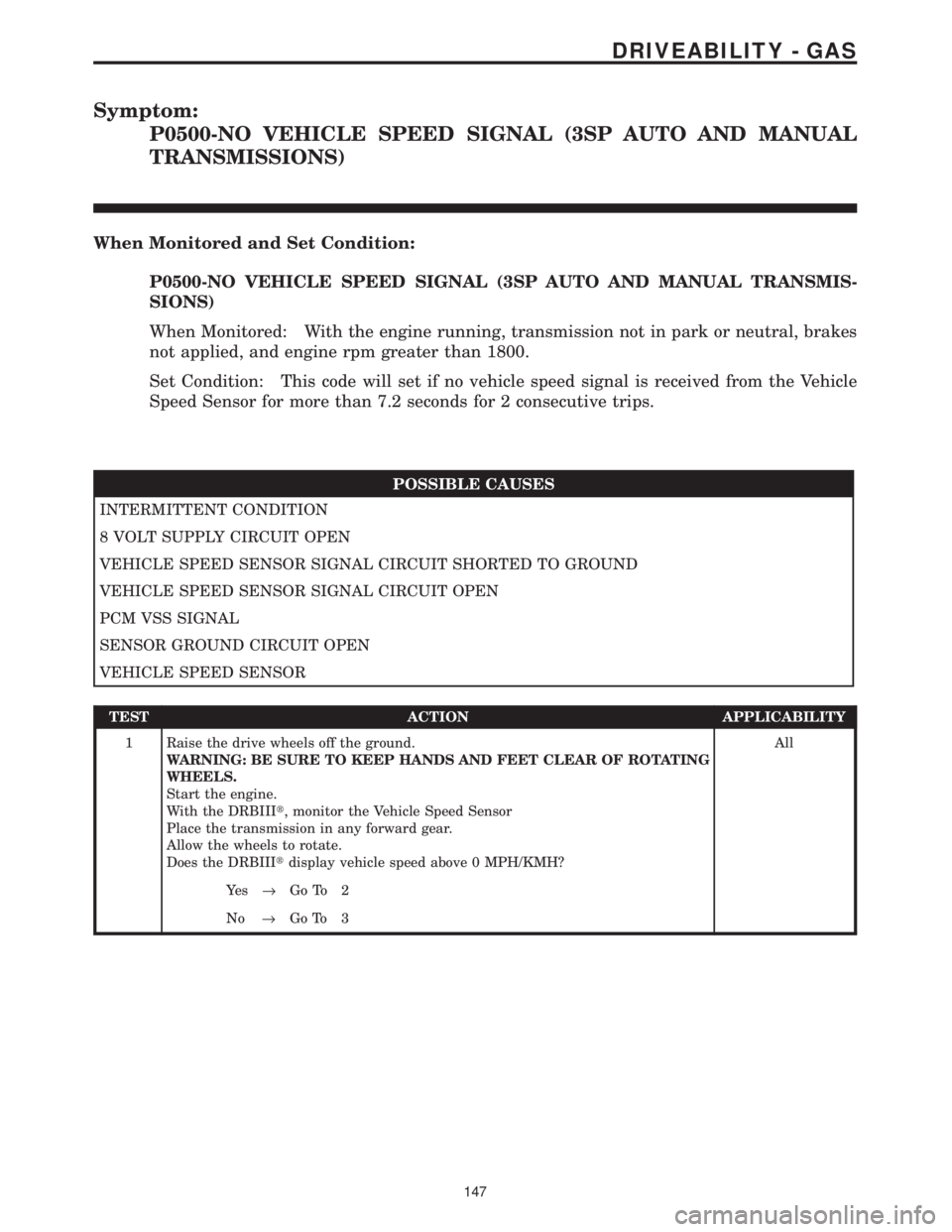
Symptom:
P0500-NO VEHICLE SPEED SIGNAL (3SP AUTO AND MANUAL
TRANSMISSIONS)
When Monitored and Set Condition:
P0500-NO VEHICLE SPEED SIGNAL (3SP AUTO AND MANUAL TRANSMIS-
SIONS)
When Monitored: With the engine running, transmission not in park or neutral, brakes
not applied, and engine rpm greater than 1800.
Set Condition: This code will set if no vehicle speed signal is received from the Vehicle
Speed Sensor for more than 7.2 seconds for 2 consecutive trips.
POSSIBLE CAUSES
INTERMITTENT CONDITION
8 VOLT SUPPLY CIRCUIT OPEN
VEHICLE SPEED SENSOR SIGNAL CIRCUIT SHORTED TO GROUND
VEHICLE SPEED SENSOR SIGNAL CIRCUIT OPEN
PCM VSS SIGNAL
SENSOR GROUND CIRCUIT OPEN
VEHICLE SPEED SENSOR
TEST ACTION APPLICABILITY
1 Raise the drive wheels off the ground.
WARNING: BE SURE TO KEEP HANDS AND FEET CLEAR OF ROTATING
WHEELS.
Start the engine.
With the DRBIIIt, monitor the Vehicle Speed Sensor
Place the transmission in any forward gear.
Allow the wheels to rotate.
Does the DRBIIItdisplay vehicle speed above 0 MPH/KMH?All
Ye s®Go To 2
No®Go To 3
147
DRIVEABILITY - GAS
Page 3942 of 4284
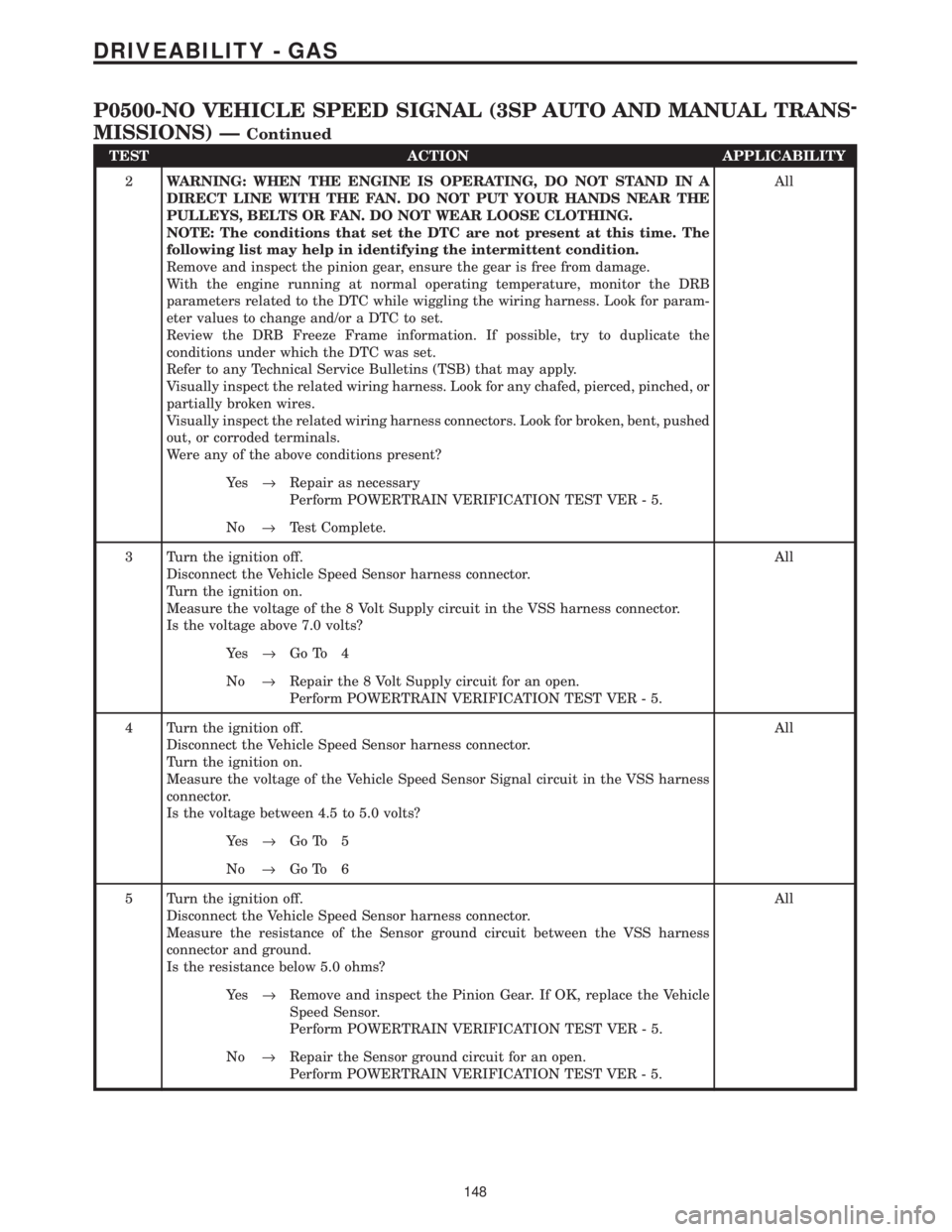
TEST ACTION APPLICABILITY
2WARNING: WHEN THE ENGINE IS OPERATING, DO NOT STAND IN A
DIRECT LINE WITH THE FAN. DO NOT PUT YOUR HANDS NEAR THE
PULLEYS, BELTS OR FAN. DO NOT WEAR LOOSE CLOTHING.
NOTE: The conditions that set the DTC are not present at this time. The
following list may help in identifying the intermittent condition.
Remove and inspect the pinion gear, ensure the gear is free from damage.
With the engine running at normal operating temperature, monitor the DRB
parameters related to the DTC while wiggling the wiring harness. Look for param-
eter values to change and/or a DTC to set.
Review the DRB Freeze Frame information. If possible, try to duplicate the
conditions under which the DTC was set.
Refer to any Technical Service Bulletins (TSB) that may apply.
Visually inspect the related wiring harness. Look for any chafed, pierced, pinched, or
partially broken wires.
Visually inspect the related wiring harness connectors. Look for broken, bent, pushed
out, or corroded terminals.
Were any of the above conditions present?All
Ye s®Repair as necessary
Perform POWERTRAIN VERIFICATION TEST VER - 5.
No®Test Complete.
3 Turn the ignition off.
Disconnect the Vehicle Speed Sensor harness connector.
Turn the ignition on.
Measure the voltage of the 8 Volt Supply circuit in the VSS harness connector.
Is the voltage above 7.0 volts?All
Ye s®Go To 4
No®Repair the 8 Volt Supply circuit for an open.
Perform POWERTRAIN VERIFICATION TEST VER - 5.
4 Turn the ignition off.
Disconnect the Vehicle Speed Sensor harness connector.
Turn the ignition on.
Measure the voltage of the Vehicle Speed Sensor Signal circuit in the VSS harness
connector.
Is the voltage between 4.5 to 5.0 volts?All
Ye s®Go To 5
No®Go To 6
5 Turn the ignition off.
Disconnect the Vehicle Speed Sensor harness connector.
Measure the resistance of the Sensor ground circuit between the VSS harness
connector and ground.
Is the resistance below 5.0 ohms?All
Ye s®Remove and inspect the Pinion Gear. If OK, replace the Vehicle
Speed Sensor.
Perform POWERTRAIN VERIFICATION TEST VER - 5.
No®Repair the Sensor ground circuit for an open.
Perform POWERTRAIN VERIFICATION TEST VER - 5.
148
DRIVEABILITY - GAS
P0500-NO VEHICLE SPEED SIGNAL (3SP AUTO AND MANUAL TRANS-
MISSIONS) Ð
Continued
Page 3943 of 4284
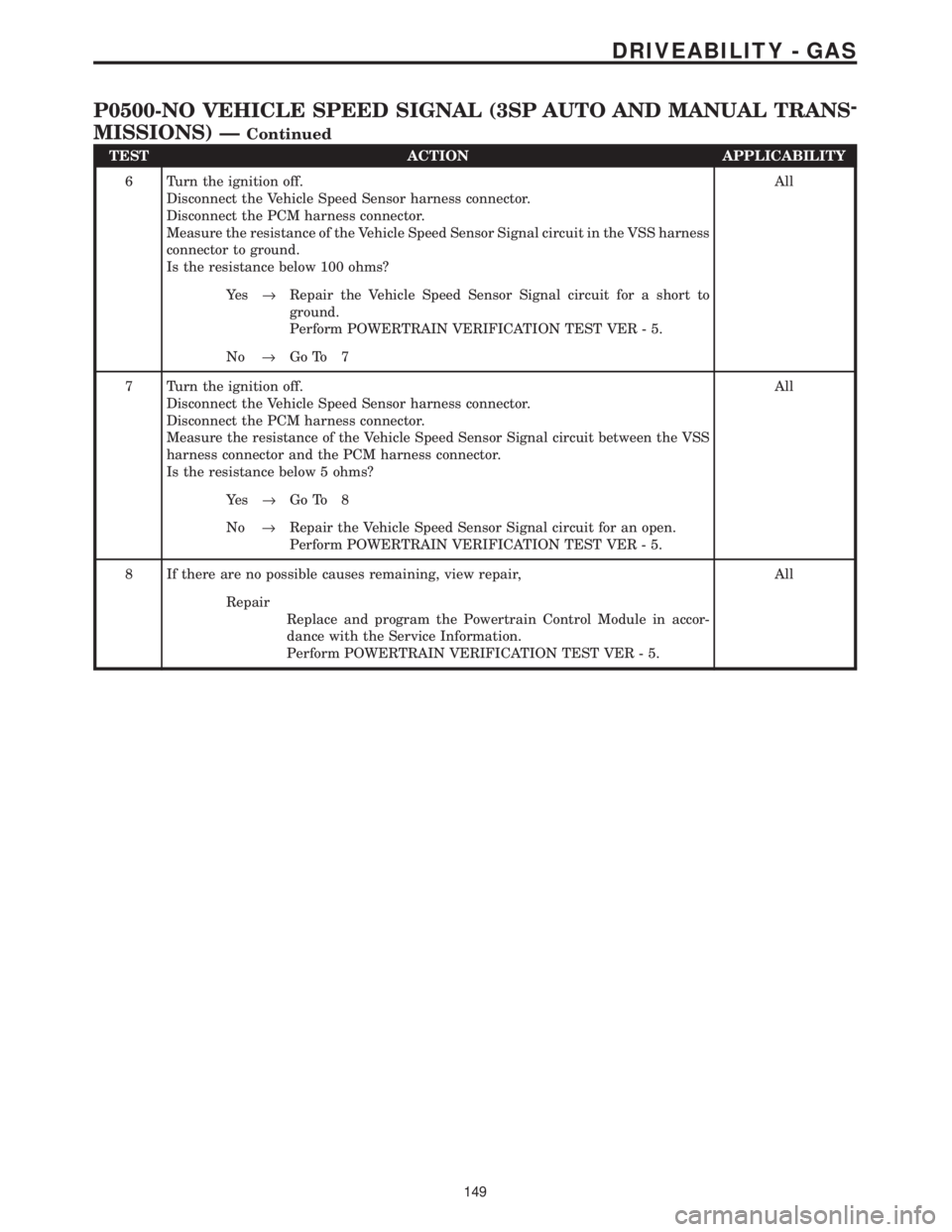
TEST ACTION APPLICABILITY
6 Turn the ignition off.
Disconnect the Vehicle Speed Sensor harness connector.
Disconnect the PCM harness connector.
Measure the resistance of the Vehicle Speed Sensor Signal circuit in the VSS harness
connector to ground.
Is the resistance below 100 ohms?All
Ye s®Repair the Vehicle Speed Sensor Signal circuit for a short to
ground.
Perform POWERTRAIN VERIFICATION TEST VER - 5.
No®Go To 7
7 Turn the ignition off.
Disconnect the Vehicle Speed Sensor harness connector.
Disconnect the PCM harness connector.
Measure the resistance of the Vehicle Speed Sensor Signal circuit between the VSS
harness connector and the PCM harness connector.
Is the resistance below 5 ohms?All
Ye s®Go To 8
No®Repair the Vehicle Speed Sensor Signal circuit for an open.
Perform POWERTRAIN VERIFICATION TEST VER - 5.
8 If there are no possible causes remaining, view repair, All
Repair
Replace and program the Powertrain Control Module in accor-
dance with the Service Information.
Perform POWERTRAIN VERIFICATION TEST VER - 5.
149
DRIVEABILITY - GAS
P0500-NO VEHICLE SPEED SIGNAL (3SP AUTO AND MANUAL TRANS-
MISSIONS) Ð
Continued
Page 3944 of 4284
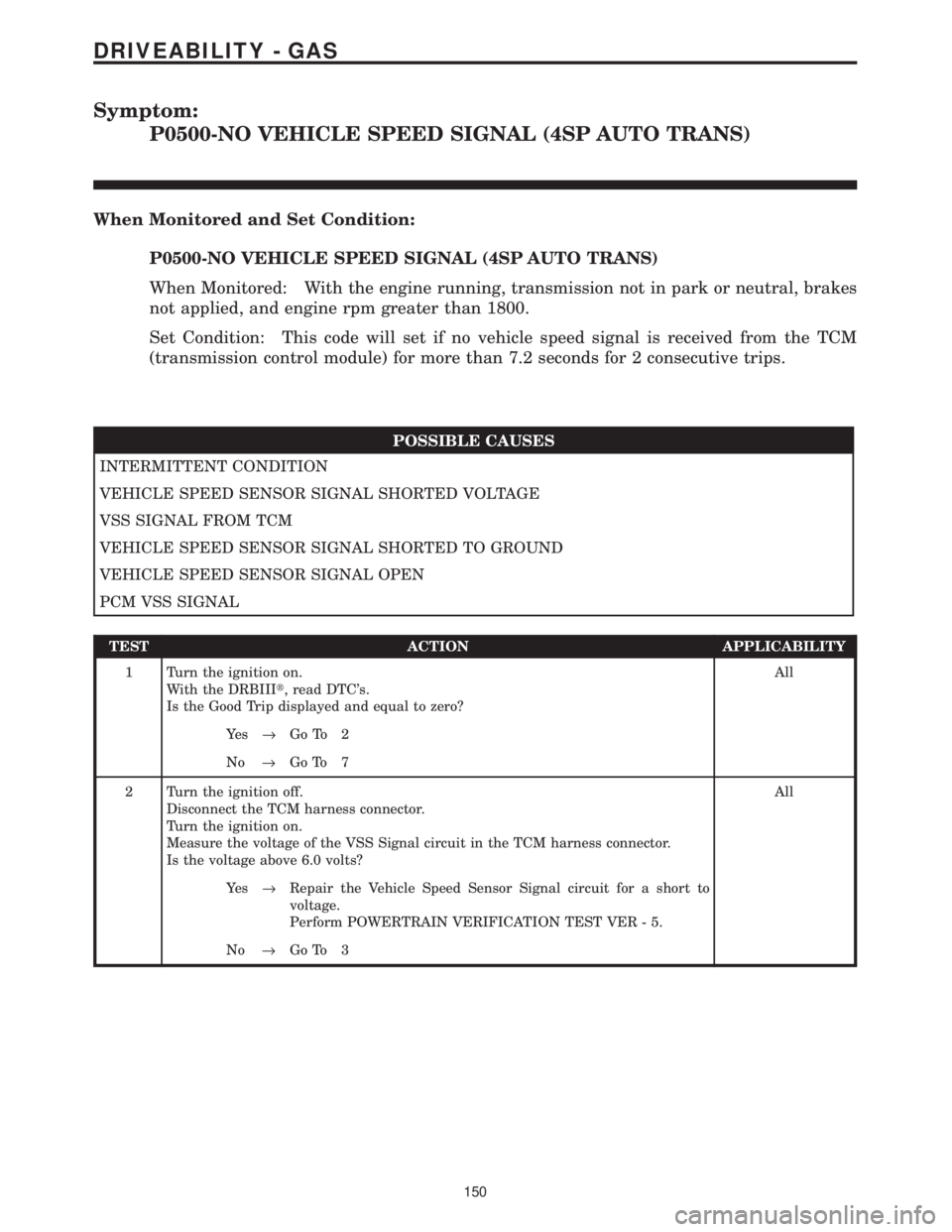
Symptom:
P0500-NO VEHICLE SPEED SIGNAL (4SP AUTO TRANS)
When Monitored and Set Condition:
P0500-NO VEHICLE SPEED SIGNAL (4SP AUTO TRANS)
When Monitored: With the engine running, transmission not in park or neutral, brakes
not applied, and engine rpm greater than 1800.
Set Condition: This code will set if no vehicle speed signal is received from the TCM
(transmission control module) for more than 7.2 seconds for 2 consecutive trips.
POSSIBLE CAUSES
INTERMITTENT CONDITION
VEHICLE SPEED SENSOR SIGNAL SHORTED VOLTAGE
VSS SIGNAL FROM TCM
VEHICLE SPEED SENSOR SIGNAL SHORTED TO GROUND
VEHICLE SPEED SENSOR SIGNAL OPEN
PCM VSS SIGNAL
TEST ACTION APPLICABILITY
1 Turn the ignition on.
With the DRBIIIt, read DTC's.
Is the Good Trip displayed and equal to zero?All
Ye s®Go To 2
No®Go To 7
2 Turn the ignition off.
Disconnect the TCM harness connector.
Turn the ignition on.
Measure the voltage of the VSS Signal circuit in the TCM harness connector.
Is the voltage above 6.0 volts?All
Ye s®Repair the Vehicle Speed Sensor Signal circuit for a short to
voltage.
Perform POWERTRAIN VERIFICATION TEST VER - 5.
No®Go To 3
150
DRIVEABILITY - GAS
Page 3945 of 4284
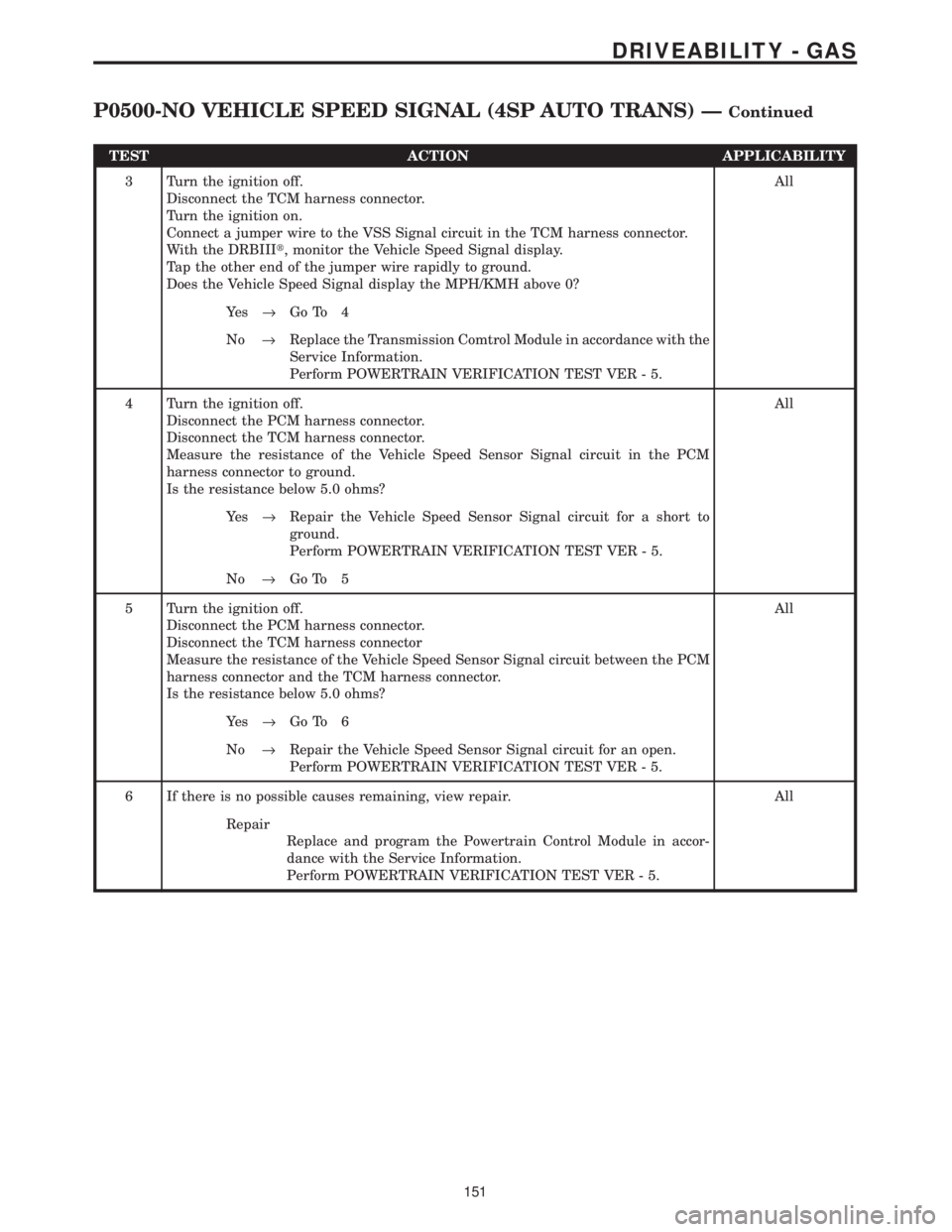
TEST ACTION APPLICABILITY
3 Turn the ignition off.
Disconnect the TCM harness connector.
Turn the ignition on.
Connect a jumper wire to the VSS Signal circuit in the TCM harness connector.
With the DRBIIIt, monitor the Vehicle Speed Signal display.
Tap the other end of the jumper wire rapidly to ground.
Does the Vehicle Speed Signal display the MPH/KMH above 0?All
Ye s®Go To 4
No®Replace the Transmission Comtrol Module in accordance with the
Service Information.
Perform POWERTRAIN VERIFICATION TEST VER - 5.
4 Turn the ignition off.
Disconnect the PCM harness connector.
Disconnect the TCM harness connector.
Measure the resistance of the Vehicle Speed Sensor Signal circuit in the PCM
harness connector to ground.
Is the resistance below 5.0 ohms?All
Ye s®Repair the Vehicle Speed Sensor Signal circuit for a short to
ground.
Perform POWERTRAIN VERIFICATION TEST VER - 5.
No®Go To 5
5 Turn the ignition off.
Disconnect the PCM harness connector.
Disconnect the TCM harness connector
Measure the resistance of the Vehicle Speed Sensor Signal circuit between the PCM
harness connector and the TCM harness connector.
Is the resistance below 5.0 ohms?All
Ye s®Go To 6
No®Repair the Vehicle Speed Sensor Signal circuit for an open.
Perform POWERTRAIN VERIFICATION TEST VER - 5.
6 If there is no possible causes remaining, view repair. All
Repair
Replace and program the Powertrain Control Module in accor-
dance with the Service Information.
Perform POWERTRAIN VERIFICATION TEST VER - 5.
151
DRIVEABILITY - GAS
P0500-NO VEHICLE SPEED SIGNAL (4SP AUTO TRANS) ÐContinued
Page 3960 of 4284
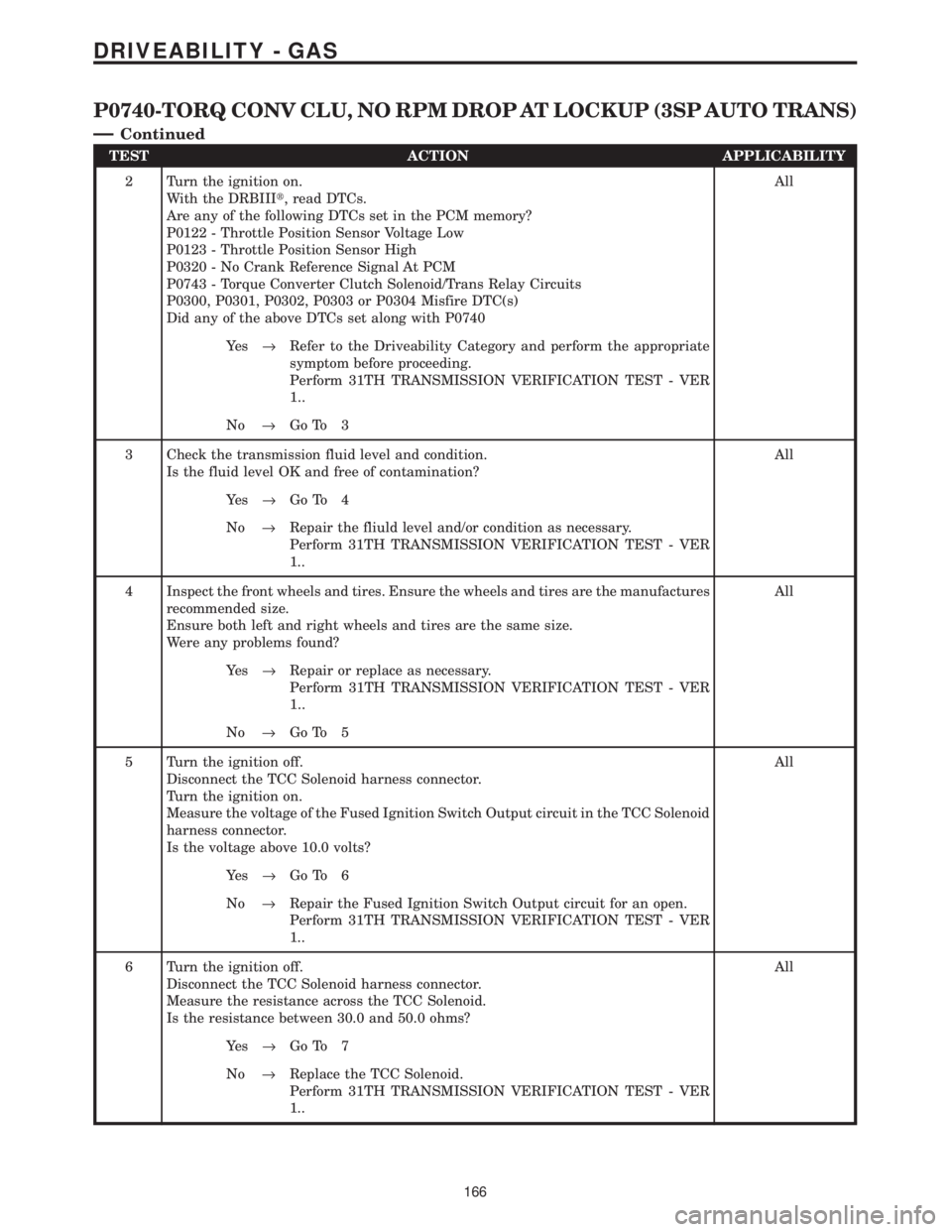
TEST ACTION APPLICABILITY
2 Turn the ignition on.
With the DRBIIIt, read DTCs.
Are any of the following DTCs set in the PCM memory?
P0122 - Throttle Position Sensor Voltage Low
P0123 - Throttle Position Sensor High
P0320 - No Crank Reference Signal At PCM
P0743 - Torque Converter Clutch Solenoid/Trans Relay Circuits
P0300, P0301, P0302, P0303 or P0304 Misfire DTC(s)
Did any of the above DTCs set along with P0740All
Ye s®Refer to the Driveability Category and perform the appropriate
symptom before proceeding.
Perform 31TH TRANSMISSION VERIFICATION TEST - VER
1..
No®Go To 3
3 Check the transmission fluid level and condition.
Is the fluid level OK and free of contamination?All
Ye s®Go To 4
No®Repair the fliuld level and/or condition as necessary.
Perform 31TH TRANSMISSION VERIFICATION TEST - VER
1..
4 Inspect the front wheels and tires. Ensure the wheels and tires are the manufactures
recommended size.
Ensure both left and right wheels and tires are the same size.
Were any problems found?All
Ye s®Repair or replace as necessary.
Perform 31TH TRANSMISSION VERIFICATION TEST - VER
1..
No®Go To 5
5 Turn the ignition off.
Disconnect the TCC Solenoid harness connector.
Turn the ignition on.
Measure the voltage of the Fused Ignition Switch Output circuit in the TCC Solenoid
harness connector.
Is the voltage above 10.0 volts?All
Ye s®Go To 6
No®Repair the Fused Ignition Switch Output circuit for an open.
Perform 31TH TRANSMISSION VERIFICATION TEST - VER
1..
6 Turn the ignition off.
Disconnect the TCC Solenoid harness connector.
Measure the resistance across the TCC Solenoid.
Is the resistance between 30.0 and 50.0 ohms?All
Ye s®Go To 7
No®Replace the TCC Solenoid.
Perform 31TH TRANSMISSION VERIFICATION TEST - VER
1..
166
DRIVEABILITY - GAS
P0740-TORQ CONV CLU, NO RPM DROP AT LOCKUP (3SP AUTO TRANS)
Ð
Continued
Page 3968 of 4284
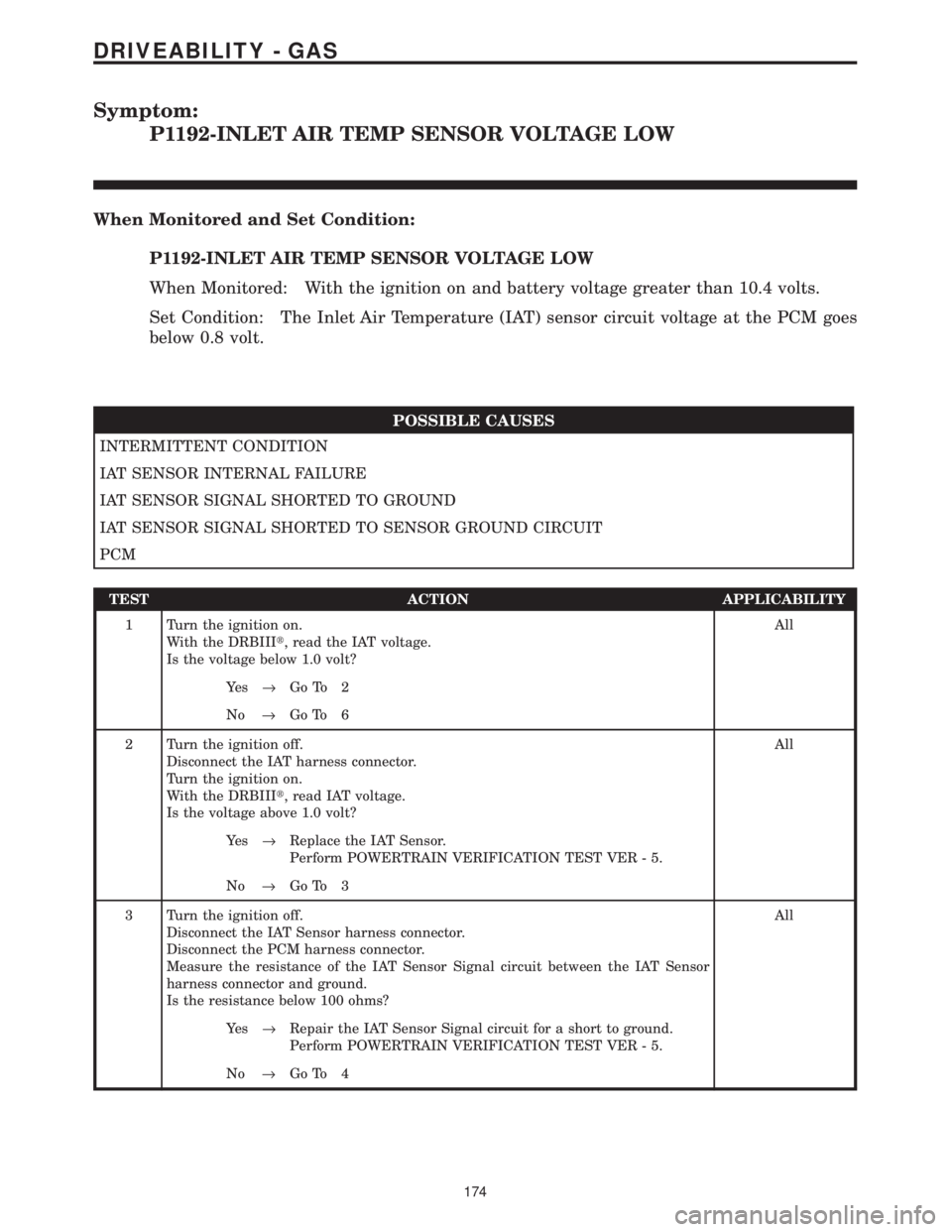
Symptom:
P1192-INLET AIR TEMP SENSOR VOLTAGE LOW
When Monitored and Set Condition:
P1192-INLET AIR TEMP SENSOR VOLTAGE LOW
When Monitored: With the ignition on and battery voltage greater than 10.4 volts.
Set Condition: The Inlet Air Temperature (IAT) sensor circuit voltage at the PCM goes
below 0.8 volt.
POSSIBLE CAUSES
INTERMITTENT CONDITION
IAT SENSOR INTERNAL FAILURE
IAT SENSOR SIGNAL SHORTED TO GROUND
IAT SENSOR SIGNAL SHORTED TO SENSOR GROUND CIRCUIT
PCM
TEST ACTION APPLICABILITY
1 Turn the ignition on.
With the DRBIIIt, read the IAT voltage.
Is the voltage below 1.0 volt?All
Ye s®Go To 2
No®Go To 6
2 Turn the ignition off.
Disconnect the IAT harness connector.
Turn the ignition on.
With the DRBIIIt, read IAT voltage.
Is the voltage above 1.0 volt?All
Ye s®Replace the IAT Sensor.
Perform POWERTRAIN VERIFICATION TEST VER - 5.
No®Go To 3
3 Turn the ignition off.
Disconnect the IAT Sensor harness connector.
Disconnect the PCM harness connector.
Measure the resistance of the IAT Sensor Signal circuit between the IAT Sensor
harness connector and ground.
Is the resistance below 100 ohms?All
Ye s®Repair the IAT Sensor Signal circuit for a short to ground.
Perform POWERTRAIN VERIFICATION TEST VER - 5.
No®Go To 4
174
DRIVEABILITY - GAS
Page 3969 of 4284
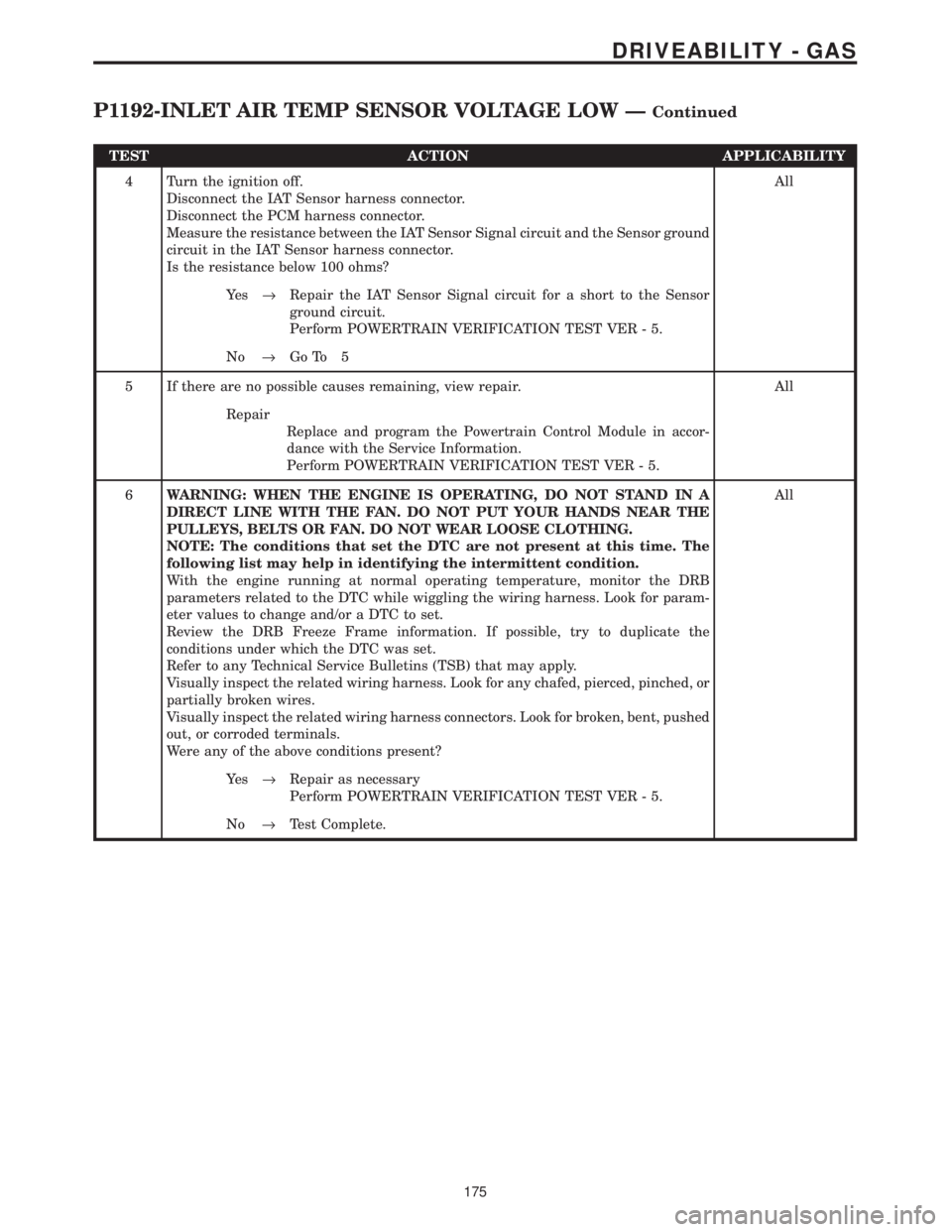
TEST ACTION APPLICABILITY
4 Turn the ignition off.
Disconnect the IAT Sensor harness connector.
Disconnect the PCM harness connector.
Measure the resistance between the IAT Sensor Signal circuit and the Sensor ground
circuit in the IAT Sensor harness connector.
Is the resistance below 100 ohms?All
Ye s®Repair the IAT Sensor Signal circuit for a short to the Sensor
ground circuit.
Perform POWERTRAIN VERIFICATION TEST VER - 5.
No®Go To 5
5 If there are no possible causes remaining, view repair. All
Repair
Replace and program the Powertrain Control Module in accor-
dance with the Service Information.
Perform POWERTRAIN VERIFICATION TEST VER - 5.
6WARNING: WHEN THE ENGINE IS OPERATING, DO NOT STAND IN A
DIRECT LINE WITH THE FAN. DO NOT PUT YOUR HANDS NEAR THE
PULLEYS, BELTS OR FAN. DO NOT WEAR LOOSE CLOTHING.
NOTE: The conditions that set the DTC are not present at this time. The
following list may help in identifying the intermittent condition.
With the engine running at normal operating temperature, monitor the DRB
parameters related to the DTC while wiggling the wiring harness. Look for param-
eter values to change and/or a DTC to set.
Review the DRB Freeze Frame information. If possible, try to duplicate the
conditions under which the DTC was set.
Refer to any Technical Service Bulletins (TSB) that may apply.
Visually inspect the related wiring harness. Look for any chafed, pierced, pinched, or
partially broken wires.
Visually inspect the related wiring harness connectors. Look for broken, bent, pushed
out, or corroded terminals.
Were any of the above conditions present?All
Ye s®Repair as necessary
Perform POWERTRAIN VERIFICATION TEST VER - 5.
No®Test Complete.
175
DRIVEABILITY - GAS
P1192-INLET AIR TEMP SENSOR VOLTAGE LOW ÐContinued